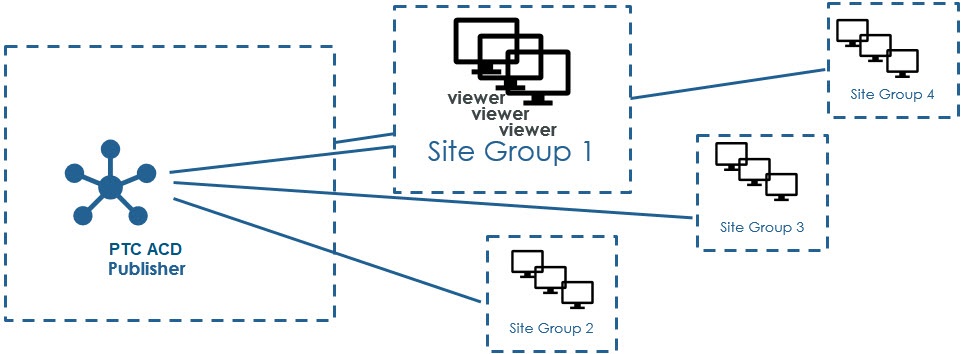Terminology
This chapter defines some of the terms and concepts used in PTC Arbortext Content Delivery. The following types of terms are covered:
• Content logical terms
• Physical terms
• Other terms
Content Logical Terms
The content contained in PTC Arbortext Content Delivery is stored and defined based on a set of logical containers. The following terms are used to describe how content is grouped.
Context
A context represents a group of products, such as a product family, model, and so forth. An example of a context is the Effectivity Context used in Windchill Service Information Manager and Windchill Service Parts.
The context is represented as a product hierarchy node in the product hierarchy (PH). For example, a context can be the model of a vehicle:

In this case, 301, 3008, and 2008 are car models used as a context.
Collection
A collection is a logical way to divide and load data into PTC Arbortext Content Delivery. It is an aggregation of the different contexts included in the data bundle. In general, the data included in a collection should be the lowest level at which you want to manage the data. For example, a collection could be at the level where you expect to have to update different content areas.
A collection can be one of the following two types:
◦ Product related content – the content associated with the PH
◦ Non-product related content – general content, such as training materials, system guides, marketing documents and so forth
For example, collections could be based on the type of vehicle:

Segment
A segment is a physical separation of the content that consists of one of more collections. Content is divided into segments to optimize performance on the viewer server. Deciding how to divide your data into segments should consider the following factors:
◦ The amount of content for each segment, such as the number of words
◦ The relationships within the content, such as the references or links between documents or documents shared between collections
◦ The number of collections included in a segment.
By default, each PTC Arbortext Content Delivery deployment contains a shared segment for parts data. All other segments are added using the Task Manager.
For example, segments could be based by company:

Physical Terms
PTC Arbortext Content Delivery content is stored and delivered by various types of repositories, databases, and servers. The following terms describe the physical components of the system.
E3C Storage Repository and Core Servers
The E3C storage repository is an XML-based file storage that contains the compressed textual content (PDF and XML documents), as well as index files used for storage, linking, filtering, and so forth. Each segment contains a repository.
There are two types of core servers: core CMI servers and core servers. The core CMI server is the software entity that manages content loading to the repositories. There is only one core CMI server for a site. Core servers manage document retrieval, search, filtering, and so forth. Each deployment can have one or more core servers. Each core server manages one or more repositories. Multiple core servers are connected to the application using a Load Balancer.
For example, following is a deployment with two core servers that each manage multiple repositories:

Database and File System Storage
PTC Arbortext Content Delivery also uses a database and file system storage to manage additional content that should not be indexed in the E3C storage repository. The database is used to store dynamic data such as users, notes, bookmarks, and shopping carts. The file system is used to store images, media files, and so forth.
For example, following is the previous deployment with the application and storage added:

Viewers
A viewer is the end point where a user can see the data contained in PTC Arbortext Content Delivery. The system supports different kinds of viewers including online and offline workstations and tablets.
For example, following is the previous deployment with viewers added:

Sites
PTC Arbortext Content Delivery supports the following types of sites:
◦ Remote site – a viewer installed on a machine that is different from the publisher server.
◦ Site group – a group is one or more remote sites that contain the same content. When the data is updated in this case, all sites in the group are updated with the same data simultaneously.
Following is an example of PTC Arbortext Content Delivery sites:

Offline and Packets
PTC Arbortext Content Delivery support offline installation and operation. Offline systems are those installed directly on user workstations, so that users can still view content after disconnecting from the internet. The data in an offline site is updated by synchronizing with the PTC Arbortext Content Delivery download center. The download center contains the data packets for an offline site.
There are the following two types of data packets:
◦ Full or initial packet – includes the entire content of the collections in the segments
◦ Incremental packet – includes an update to a collection
Following is an example of a PTC Arbortext Content Delivery Offline deployment:

Other Terms
This section contains other terms related to a PTC Arbortext Content Delivery deployment.
Assets
Assets are PTC Arbortext Content Delivery configuration files used to index and display data. An example of an asset is the Type Property files that control various TAL functionality and other functionality, such as content indexing, linking, and so forth.
Another type of asset is the stylesheets used for viewer content display:
